What is an All-in-One Solar Power System?
An all-in-one solar power system is a comprehensive solution designed to provide everything you need to harness solar energy in a single package.
The basic components of an all-in-one solar power system include:
Solar Panels: Capture sunlight and convert it into direct current (DC) electricity.
MPPT Solar Charge Controller: Optimizes the energy harvested from the solar panels by ensuring they operate at their maximum power point.
Inverter: Converts the DC electricity generated by the solar panels into alternating current (AC), which is used by most household appliances.
Battery Storage: Stores excess energy produced during the day for use during nighttime or cloudy periods.
Integrated Management System: Coordinates the operation of all components, ensuring seamless energy production, storage, and usage.
These systems combine all the essential components required to convert sunlight into electricity and manage its distribution throughout your home.
Convenience and Efficiency of All-in-One Systems
The convenience of all-in-one solar power system cannot be overstated. They are designed for quick and easy installation, often requiring minimal technical expertise. This makes them an ideal choice for homeowners looking to adopt solar energy without the hassle of coordinating multiple components and installers.
Additionally, all-in-one systems are highly efficient. By integrating all components into a single unit, these systems reduce energy losses that can occur when separate parts are connected. The integrated management system ensures that the solar panels, charge controller, inverter, and battery storage operate harmoniously, maximizing energy production and usage.
Components of an All-in-One Solar Power System
Solar Panels
Solar panels are the cornerstone of any solar power system. They capture sunlight and convert it into electricity using photovoltaic (PV) cells. These cells are made of semiconductor materials, typically silicon, which generate direct current (DC) electricity when exposed to sunlight. The efficiency of this conversion process determines how much electricity can be produced from the available sunlight.
MPPT Solar Charge Controller
The Maximum Power Point Tracking (MPPT) solar charge controller is a critical component that optimizes the energy harvest from solar panels. It continuously monitors the voltage and current output of the panels and adjusts the electrical operating point to ensure that the panels operate at their maximum power point. This optimization increases the efficiency of the system, allowing it to extract the maximum possible energy from the sunlight.
Inverter
The inverter plays a crucial role in converting the DC electricity generated by the solar panels into alternating current (AC) electricity, which is the standard form of electricity used by household appliances. Without the inverter, the solar-generated electricity would not be compatible with most home electrical systems. The inverter ensures a seamless integration of solar power into your home’s electrical grid, enabling you to power your appliances and devices with clean, renewable energy.
Battery Storage
Battery storage units are essential for storing excess energy produced by the solar panels during the day. This stored energy can be used during nighttime or on cloudy days when solar production is low. Battery storage systems ensure a continuous and reliable power supply, allowing you to maximize the use of solar energy and reduce dependence on the traditional electrical grid.

Integrated Management System
All-in-one solar power system coordinates the operation of all components, ensuring seamless energy production, storage, and usage. This system monitors the performance of the solar panels, charge controller, inverter, and battery storage, making real-time adjustments to optimize efficiency. It also provides valuable insights and data on your energy consumption and production, helping you to manage and maintain your system effectively.
How All-in-One Solar Power Systems Work
Step-by-Step Explanation of the Energy Conversion Process
Sunlight Capture:
Solar panels, composed of photovoltaic (PV) cells, are installed on your roof or another location with ample sunlight exposure. These panels capture sunlight and convert it into direct current (DC) electricity.
Optimizing Energy Harvest:
The DC electricity produced by the solar panels flows into the MPPT (Maximum Power Point Tracking) solar charge controller. This device optimizes the energy harvest by continuously adjusting the electrical operating point of the panels to ensure they operate at their maximum power point, maximizing efficiency.
DC to AC Conversion:
The optimized DC electricity is then sent to the inverter. The inverter converts the DC electricity into alternating current (AC) electricity, which is the standard form of electricity used by household appliances and devices.
Energy Storage:
Any excess electricity that is not immediately used by your home is stored in battery storage units. These batteries save the excess energy produced during the day, which can be used at night or during periods of low sunlight.
Integrated Management:
The integrated management system coordinates the operation of all components. It ensures that solar panels, the MPPT charge controller, the inverter, and battery storage work seamlessly together. The system monitors energy production and consumption, making real-time adjustments to optimize performance and efficiency.
Powering Your Home:
The AC electricity produced by the inverter is distributed throughout your home to power your lights, appliances, and other electronic devices. During periods when solar energy production is low, the system can draw stored energy from the batteries, ensuring a continuous and reliable power supply.
Use of Infographics to Visually Illustrate the Process
To better understand the process, consider the following infographic components:
Solar Panels capturing sunlight at the top.
Arrows indicating the flow of DC electricity to the MPPT Solar Charge Controller.
MPPT Controller optimizing the energy flow with a visual representation of maximum power point tracking.
DC electricity moving to the Inverter and being converted to AC electricity.
Battery Storage units storing excess energy with arrows showing the flow of electricity back and forth.

The Integrated Management System overseeing and coordinating all components, with icons representing real-time monitoring and adjustments.
AC Electricity flowing from the inverter to the household grid, powering various home appliances.
Highlighting the Efficiency and Simplicity of the Integrated System
All-in-one solar power systems are designed for maximum efficiency and simplicity. By integrating all necessary components into a single unit, these systems minimize energy losses and ensure that each part works optimally with the others. The MPPT charge controller maximizes energy harvest, while the inverter ensures that electricity is ready for home use. Battery storage provides a reliable backup, and the integrated management system oversees the entire process, making real-time adjustments to optimize performance.
Advantages of All-in-One Solar Power Systems
Easy Installation and Maintenance
All-in-one solar power systems are designed for straightforward installation. Since all components are integrated into a single unit, the need for complex wiring and multiple installers is eliminated. This not only reduces the time and effort required for setup but also minimizes the potential for installation errors. Additionally, maintenance is simplified as the integrated system requires fewer individual checks and repairs, making it easier to keep your solar power system running smoothly.
Space-Saving Design
The compact, all-in-one design of these solar power systems means they occupy less space compared to traditional setups that require separate components. This space-saving feature is particularly beneficial for homes with limited roof or storage space. By consolidating all essential parts into one unit, you can maximize the available area for energy production without compromising on performance.
Enhanced Energy Efficiency
All-in-one solar power systems are engineered for optimal efficiency. The integration of components like the MPPT charge controller and inverter ensures that energy conversion and storage are maximized, reducing energy losses that can occur with separate units. The MPPT technology continuously optimizes the performance of solar panels, ensuring that they operate at their maximum power point, which significantly enhances overall system efficiency.
Cost-Effectiveness in the Long Run
While the initial investment in an all-in-one solar power system may be comparable to or slightly higher than traditional systems, the long-term savings are substantial. The efficiency gains, reduced installation and maintenance costs, and reliable performance translate into lower energy bills and fewer expenses over time. Additionally, the streamlined design and integration reduce the likelihood of costly repairs and replacements, making these systems a financially sound choice in the long run.
Scalability for Future Energy Needs
All-in-one solar power systems are highly scalable, allowing you to expand your system as your energy needs grow. Whether you want to add more solar panels, increase battery storage capacity, or integrate additional smart home features, these systems are designed to accommodate future upgrades with ease. This flexibility ensures that your solar power system can evolve with your household or business requirements, providing a sustainable and adaptable energy solution for years to come.


